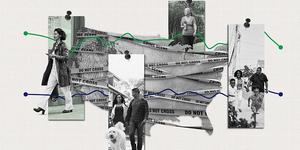Editor's Note: May 2-4, Gallup and the University of Nebraska-Lincoln will host a three-day seminar in Washington, D.C., titled "The Science of Pre-Election Polling." Gallup Poll Editor-in-Chief Frank Newport is one of 10 esteemed speakers; he will discuss the implementation of political "horse race" polls and their importance to the political process.
The mid-term elections are just about six months away, and in less than two years we will be in the midst of the 2004 presidential election primary season. At Gallup, we are already conducting horse race polls on both this year's congressional elections and on the 2004 race, as are most other polling firms. Polls are driving discussion of most of the statewide races on ballots this fall.
The number of organizations that conduct horse race polls and the frequency with which they are conducted, particularly in the national presidential race, has exponentially increased, and criticism of pre-election polls has increased almost as quickly.
Pollsters do not force pre-election horse race polls down the throat of a gullible public. Genuine interest in pre-election horse race polls exists. Polls are conducted so frequently because the decision makers who run news outlets -- editors and producers – think that they qualify for legitimate news coverage and that the public is interested in them. Indeed, Gallup's own gallup.com Web site reached its all-time high in terms of daily hits during the weeks leading up to the November 2000 election, when we were reporting the results of our daily horse-race tracking poll.
The public likes the idea of having a quantitative feel for how political races are going -- particularly when such races are dominant news stories and when their outcomes are potentially important.
Many criticisms of pre-election horse race polls focus on their alleged injurious impact on the average citizens who read about them. Critics argue that the election process is so fragile that the introduction of frequent "who's ahead" polls distorts the process, creates bandwagons for front-runners, dooms those who are behind in the polls to Election Day oblivion, and deprives voters of more legitimate news coverage. I object to these criticisms because they assume a low estimate of the abilities of average voters. Voters should be allowed to take into account whatever information they want -- including polls that show who is ahead. The allegation that poll standing early in a race freezes the election does not stand up to the evidence. Candidates who are low in the polls often go on to win elections, and candidates who are ahead in the polls early on fall back and suffer losses.
There is also abundant evidence that news coverage of major races is almost never focused only on the horse race standings. Election news includes a wide variety of information about the candidates and their issues -- and this has become more common and possible with proliferating news outlets in the last several years.
The category of objections to horse race polling that pollsters take most seriously is the focus on polls' accuracy and validity. Polls use scientific principles that have been developed over a 60-year history, and pollsters pride themselves on making them as scientifically accurate as possible. Most people don't realize that pollsters -- like professionals in other fields -- are dedicated to making their practices adhere to the highest standards. The Gallup Organization and the Gallup Research Center at the University of Nebraska-Lincoln are sponsoring a seminar in Washington, D.C., May 2-4 examining the science of pre-election polling. The annual meetings of the American Association of Public Opinion Research, held in May, will include numerous papers and sessions in which polling professionals will dissect pre-election polling methodology and look for ways to improve it.
One advantage of pre-election polls is that there is a good way to measure their accuracy -- compare the final poll-based estimates to the actual vote on Election Day. Here, for the most part, polls come off well. In November 2000, the average error in the estimate of the major U.S. pre-election polls for the percentage of the vote that George W. Bush and Al Gore obtained was 1.1%. In other words, the polls, based on small samples of a few thousand people, were able to almost exactly estimate the behavior of millions. The principles of modern probability sampling allow small percentages of the population to accurately predict what the larger population will do.
And we shouldn't forget that polling provides us with more than just the horse race standings as the election season heats up. Most importantly, they help us to identify key issues for voters, and understand voters' interests and positions, something of great importance in a democracy such as ours.
